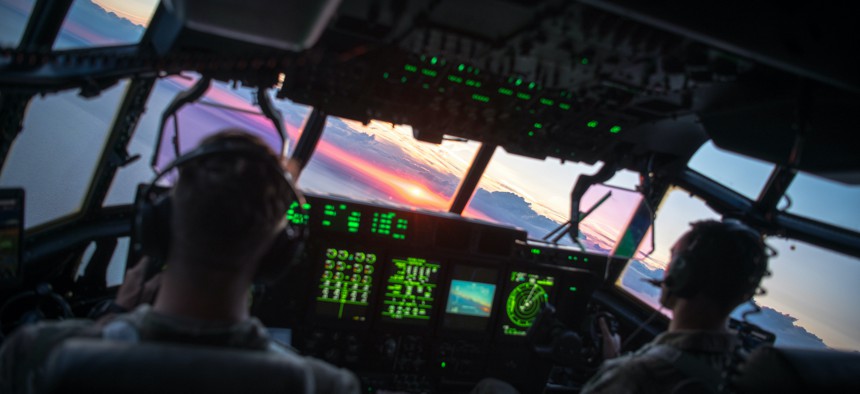
U.S. Air Force pilots assigned to the 352d Special Operations Wing fly an MC-130J Commando II during pilot proficiency training, U.K., Aug. 3, 2022. U.S. Air Force / Senior Airman Alex Kaelke
The Air & Space Brief: Deterrence theory rewrite, New influence triad, Missile defense in Guam
Welcome to the Defense One Air and Space newsletter. Here are our top stories this week:
Guam missile defense site: The Missile Defense Agency is taking first steps for a facility in Guam as part of a long-term missile defense plan in the Indo-Pacific region, Defense One’s Lauren Williams writes. But choosing the right site has been one of the program’s biggest challenges. “Our issue became siting, and siting is tough,” particularly for long-range discrimination radar, said agency director Vice Adm. Jon Hill.
Deterrence theory rewrite: The United States is “furiously” writing a new nuclear deterrence theory that simultaneously faces Russia and China, said the top commander of America’s nuclear arsenal—and needs more Americans working on how to prevent nuclear war. “We have to account for three-party [threats],” said STRATCOM chief Navy Adm. Chas Richard. “That is unprecedented in this nation's history. We have never faced two peer nuclear-capable opponents at the same time, who have to be deterred differently.”
New “influence triad:” U.S. Space Command and Army Space and Missile Defense Command are combining the military’s cyber, special operations, and space capabilities to create a new deterrent “triad” akin to the approach the U.S. uses to deter nuclear attacks. The Army is “developing an innovative way to generate asymmetrical advantages by fusing the effects of space-based cyber and SOF [special operations forces] capabilities across the compromised spectrum of conflict. This influence triad represents a key evolution in these highly specialized fields,” Gen. James Dickinson, head of U.S. Space Command said at the Space and Missile Defense Symposium in Huntsville.
Sign up to get The Air & Space Brief every Tuesday from Tara Copp, Defense One’s Senior Pentagon Reporter. On Aug. 15, 1945, President Harry S. Truman announced that Japan had surrendered, ending World War II. Victory-Japan Day was celebrated by two days of national holidays in the United States, the United Kingdom, and Australia.
 From Defense One
From Defense One
The Hardest Thing About Missile Defense in Guam? Finding the Right Site // Lauren C. Williams
There are candidate locations, but nothing is final, said Missile Defense Agency Director Vice Adm. Jon Hill.
US Military 'Furiously' Rewriting Nuclear Deterrence to Address Russia and China, STRATCOM Chief Says // Tara Copp
But America's "expertise is just not what it was at the end of the Cold War," warns Adm. Chas Richard.
New 'Influence Triad' Will Fuse SOF, Cyber, and Space Command Satellite Intelligence // Tara Copp
Information warfare cells, where space units and SOCOM work side by side, will be dispersed throughout combatant commands.




